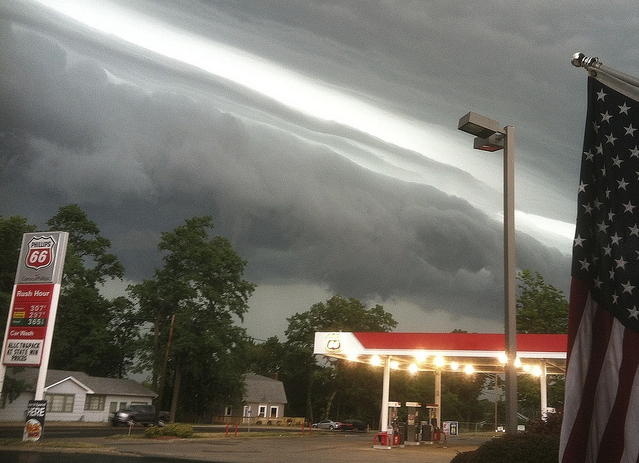Podcast: Play in new window | Download
Subscribe: RSS
The third horseman of the Apocalypse — Famine — is abroad in West Virginia today, the day after Independence Day 2012, because of a thunderstorm. In a stunning development illustrating the fragility of the industrial food chain, people in many of West Virginia’s counties began experiencing hunger three days after the storm knocked out power in their area.The storm — actually a squall line of several thunderstorms abreast in a bow-shaped line called a derecho — swept from Ohio across West Virginia, Maryland, Virginia and Washington DC to the Atlantic coast late Friday night (June 29). It was a strong storm, but not exceptionally so; its winds were not nearly as strong as a tornado’s nor as widespread as a hurricane’s, and reached hurricane strength only briefly in 80-mile-per hour gusts.
Yet this storm in effect took down the power grid for millions of people. And a full week later, hundreds of thousands remained without power. According to the lamestream media, the thing to be feared from all this was inconvenience; people accustomed to cradle-to-grave air conditioning were going to break a sweat, and commuting would be more annoying than usual.
But across wide swaths of West Virginia, the combination of blocked roads and broken power lines became, in just three days, a threat to the lives of thousands. The minuscule amounts of food stored in home refrigerators and freezers went bad in about two days. Likewise, the small amounts of food in stores.
As I explained in the book Brace for Impact, the modern management practice of “just-in-time” inventory control has replaced food warehouses and even large food storage areas in grocery stores with computerized inventory and ordering practices that are designed to ensure that new stock arrives just as — and not until — the old stock is about to be sold out. Now universal in the food business, the practice also ensures that there is nowhere in any city or neighborhood in America a stockpile of more than about two or three days’ supply of food, which vanishes in hours in any emergency that stimulates hoarding.
This storm was a regional event. Yet within three days it created a food emergency in many if not most of West Virginia’s counties, and caused tens of thousands of people to experience hunger. Relief organizations including FEMA were caught flat-footed, and belatedly began a Katrina-like operation to open feeding stations. Today, FEMA announced it had 100,000 meals on the way, and 50 tractor-trailer loads of water. They could do this, of course, because the power was on and the roads clear in, oh, about 99 per cent of the country.
Remarkably, this story does not appear in the major media today (July 5) with the sole exception of CNN. When CNN broke the story yesterday, anchorman Wolf Blitzer was visibly outraged at the idea of Americans going hungry and not getting immediate help. For a time, the network was asking the right questions, as in: wait a minute, people could starve in a situation like this? But the focus was short-lived, the the moving finger soon moved on. Their website this morning says, mildly, “Mass feeding stations planned in wake of storm.”
But instead of going back to sleep, let’s imagine an event that takes down a big chunk of the grid, and can’t be repaired for months or years. (see Apocalypse Any Minute: The Sun Storm Scenario) Think about the implications of anything that could take the 18-wheelers off the highways to your supermarket for, say, weeks or months (see, for example, Oil: More Peaked Than Ever). Then, as we say here, brace for impact.

It’s not just the US. In other places the scourge of hunger is present too.
Such as (of ALL places) this.
http://www.independent.co.uk/news/education/education-news/two-children-in-every-classroom-go-hungry-as-neglect-takes-its-toll-7912679.html